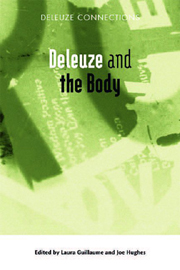Book contents
- Frontmatter
- Contents
- Introduction: Pity the Meat?: Deleuze and the Body
- DELEUZISM
- PRACTICAL DELEUZISM
- 6 The ‘Virtual’ Body and the Strange Persistence of the Flesh: Deleuze, Cyberspace and the Posthuman
- 7 ‘Be(come) Yourself only Better’: Self-transformation and the Materialisation of Images
- 8 An Ethico-Aesthetics of Heroin Chic: Art, Cliché and Capitalism
- 9 Multi-Dimensional Modifications
- 10 Dance and the Passing Moment: Deleuze's Nietzsche
- Notes on Contributors
- Index
9 - Multi-Dimensional Modifications
from PRACTICAL DELEUZISM
Published online by Cambridge University Press: 12 September 2012
- Frontmatter
- Contents
- Introduction: Pity the Meat?: Deleuze and the Body
- DELEUZISM
- PRACTICAL DELEUZISM
- 6 The ‘Virtual’ Body and the Strange Persistence of the Flesh: Deleuze, Cyberspace and the Posthuman
- 7 ‘Be(come) Yourself only Better’: Self-transformation and the Materialisation of Images
- 8 An Ethico-Aesthetics of Heroin Chic: Art, Cliché and Capitalism
- 9 Multi-Dimensional Modifications
- 10 Dance and the Passing Moment: Deleuze's Nietzsche
- Notes on Contributors
- Index
Summary
In What is Philosophy? Deleuze and Guattari posit that a concept comes from a problem. A problem is an impasse between two discourses. The problem describes the space-between, a refusal of the need for one discourse to colonise the other, a disagreement where creation is the resolution. Heavily modified bodies in Western culture offer a multiconceptual entity. They represent the impasse between philosophy (the need to create) and sociology (the need to reflect), between volition and fashion, between signification (modifications which symbolise, which mean something) and asignification (modifications which deterritorialise traditionally signified flesh), and between flesh and self (in what ways modifications de-gender and de-racialise the body). This chapter will explore the modified body as an in-between, a concept which negotiates and transgresses discourses of signified flesh and subjectivity to create a new concept of the body as liminal. These bodies allow us to navigate the plasticity of the regime of signification through which the body emerges – what Deleuze and Guattari call signifiation – and the concrete materiality of marked flesh, which involves actual pain. Bodily modified people share nothing as a ‘tribe’ except their status as in-between; thus the space they occupy comes to mean more than the essence of their being modified bodies.
Body and Skin
The most prevalent and obvious way in which modified bodies have emerged in discourse is as an object of analysis.
- Type
- Chapter
- Information
- Deleuze and the Body , pp. 188 - 202Publisher: Edinburgh University PressPrint publication year: 2011



